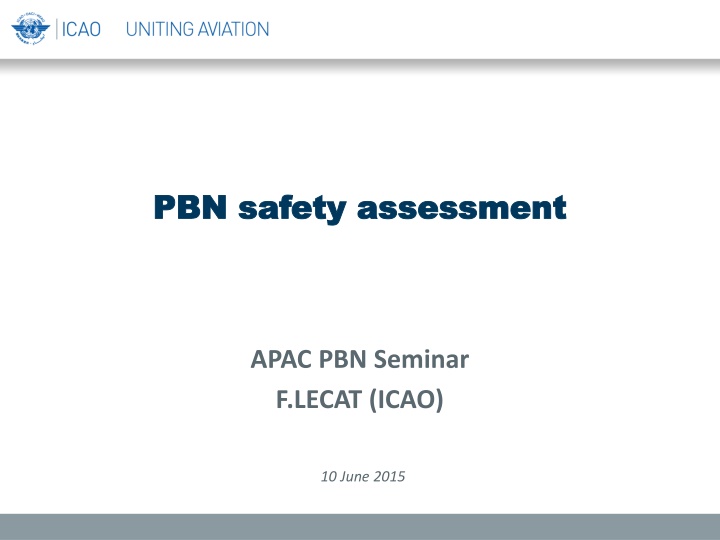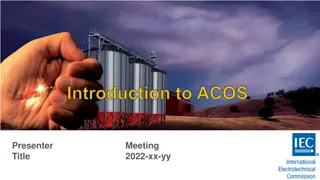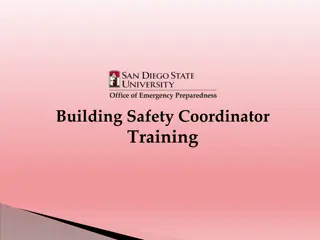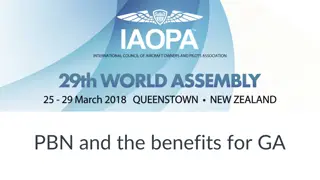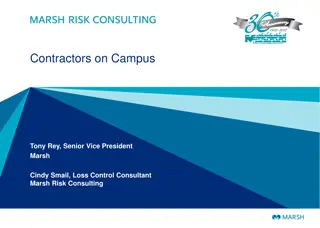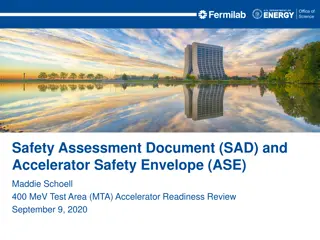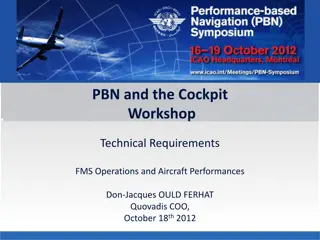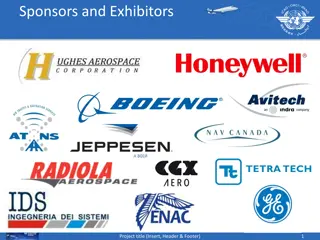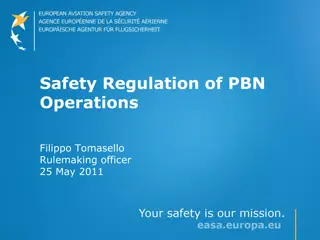PBN safety assessment PBN safety assessment
This content discusses the crucial steps involved in project planning, safety assessment, and implementation of Performance-Based Navigation (PBN) systems. It outlines the process of managing change, safety risk assessment, and the importance of a formal process to identify and mitigate safety risks associated with aviation products and services. Additionally, the content details the roles and responsibilities in the PBN Safety Assessment Initial Checklists for RNP APCH and SID/STAR transitions.
Download Presentation

Please find below an Image/Link to download the presentation.
The content on the website is provided AS IS for your information and personal use only. It may not be sold, licensed, or shared on other websites without obtaining consent from the author.If you encounter any issues during the download, it is possible that the publisher has removed the file from their server.
You are allowed to download the files provided on this website for personal or commercial use, subject to the condition that they are used lawfully. All files are the property of their respective owners.
The content on the website is provided AS IS for your information and personal use only. It may not be sold, licensed, or shared on other websites without obtaining consent from the author.
E N D
Presentation Transcript
PBN safety assessment PBN safety assessment APAC PBN Seminar F.LECAT (ICAO) 10 June 2015
Outlines Management of change PBN Safety Assessment Initial Checklists: Background First and foremost: a project framework! Safety risk management process PBN oversight 03 March 2014 2
SMS Element 3.2 The management of change ICAO Doc 9859 SMM The service provider shall develop and maintain a formal process to identify changes which may affect the level of safety risk associated with its aviation products or services and to identify and manage the safety risks that may arise from those changes. A new PBN procedure, an amendment to existing procedures, or a change in the airspace are changes that aim at bringing more efficiency and even mitigating existing risks but may also raise new risks 03 March 2014 3
Background PBNICG/1 in March 2015: PBN Safety Assessment Initial Checklists for RNP APCH and SID/STAR Transitional material until ICAO global guidance material becomes available Since PBNICG/1: clarification of checklist items, provision of reference materials, role distinction between safety assessor, a procedure designer and a procedure reviewer distinction between a new and an amended procedure Will be proposed for adoption by PBNICG 03 March 2014 4
First and foremost: a project framework! Implementation matrix: 7 stages, 30 actions Achieving measurable results Stage Number 1. PROJECT PLANNING Action A Action B Action C Action D Action E Action F 1. PROJECT PLANNING Identify the problem or improvement required Assess applicability to operating environment and State regulations Determine Key Performance Indicators and/or success criteria Gather and review data related to the desired change Assess economic feasibility and cost/benefit Start the project, determine project budget and milestones Plan tendering and maintenance contract process 2. DESIGN 2. DESIGN Determine initial design of the desired change, including alternatives Form safety teams or engage relevant safety experts Design backup and transition procedures/ steps, including reversion Develop the safety case Determine maintenance considerations Refine and agree on final design Define system validation and verification (FAT, SAT) 3. SAFETY 3. SAFETY Assess operational strengths and weaknesses, opportunities, and threats (SWOT) Coordinate Regionally and bilaterally Source relevant training experts Prepare and apply for regulatory approval or certification 4. COMMUNICATION 4. COMMUNICATION Consult with key stakeholders Conduct formal promulgation/ notification Conduct simulation and relevant training Make a Go/No-Go decision Advertise and brief about the change Assess competency and authorise Implement and monitor 5. TRAINING 5. TRAINING Develop simulations and procedures Conduct operational trials and testing Develop review -Lessons learnt -KPI achievement -Report 6. IMPLEMENTATION Assess stability and performance 6. IMPLEMENTATION 7. POST - IMPLEMENTATION Monitor medium and long term performance and safety 7. POST -IMPLEMENTATION 5 Implementing Seamless ATM in APAC
First and foremost: a project framework! 03 March 2014 6
Safety risk management process Should be conducted in accordance with the State/Administration SMS: a) the safety policy and objectives; b) SMS requirements; c) SMS processes and procedures; d) accountabilities, responsibilities and authorities for SMS processes and procedures; and e) SMS outputs. Oversight by an oversight entity 03 March 2014 7
Safety risk management process 03 March 2014 8
Draft checklists available PBN Procedure Safety Assessment Initial Checklist RNP APCH PBN Procedure Safety Assessment Initial Checklist SID/STAR PBN Safety Assessment Initial Checklist ATS Route 03 March 2014 9
Qualitative safety risk assessment matrix Tolerability Description Assessed Risk Index 5A, 5B, 5C, 4A, 4B, 3A Suggested Criteria Unacceptable under the existing circumstances , , , , , , , , , , Acceptable based on risk mitigation. It may require management decision. 3E, 2D, 2E, 1B, 1C, 1D, 1E Acceptable 10 June 15 10
Safety risk assessment matrix Unless otherwise specified by national SMS Qualitative matrix could be used for a new or an amended domestic and continental ATS route. However, a quantitative method has to be applied when a target route is established in high seas and/or separation between aircraft or ATS routes is less than recommended in ICAO documents such as PBN Manual (Doc 9613) and PANS-ATM (doc 4444) Quantitative safety assessment can be assisted by sub- regional En-route Monitoring Agency (EMA) which is approved by Regional Airspace Safety Monitoring Advisory Group (RASMAG) of APANPIRG and provides airspace safety assessment, monitoring and implementation services for international airspace in the Asia/Pacific region 03 March 2014 11
Record on Identification, Analysis and Mitigation of Hazard (can be used if no other document is available as part of the SMS procedures) 03 March 2014 12
Safety performance monitoring and measurement 3.1.1 The service provider shall develop and maintain the means to verify the safety performance of the organization and to validate the effectiveness of safety risk controls. 3.1.2 The service provider s safety performance shall be verified in reference to the safety performance indicators and safety performance targets of the SMS. 03 March 2014 13
Simple change/ Amendment of existing procedure Identify hazards through: - Brainstorming Sessions with ALL local stakeholders (Pilots, ATCO etc) - PBN Procedure Safety Assessment Initial Checklist RNP APCH - PBN Procedure Safety Assessment Initial Checklist SID/STAR - PBN Safety Assessment Initial Checklist ATS Route - Analyse Incident Reporting Complex change (airspace impacted) Organization/People Procedures Equipment Data - Safety plan - Operational Hazard analysis, safety objectives - Collision Risk Model (CRM) - Airspace modelling - Fast-Time Simulation (FTS) - Real-Time Simulation (RTS) - Benchmarking - Analyse Incident Reporting Consider operating environment (including physical conditions, airspace and route design, runway and obstacles) and traffic density/complexity Design of procedure Contract an approved IFP designer Involve operators from the beginning Consider modelisation WGS84 Dataset (configuration) of the flight procedure desgin tool Consider existing fleet capabilities and operational approvals Identification of hazards and risk analysis (probability, severity) Consider airborne and ground sides - Airborne: airworthiness process (Manufacturer, System, Part Number, Software Version, sensors (GPS, DME/DME/IRU)) Operators should have processes for managing navigation databases Pre- - Make flight validations - OPS readiness evaluations, trials implementation Validation of procedure Data obtained from an approved supplier ( Letter of Acceptance (LOA) from Regulators) - RTCA/DO- 200A Make flight validations Contingency procedures HMI evaluation Crew workload - Ground: ATM systems, human machine interface (HMI), Navaids ANSPs: Assess outcome of flight validations and OPS readiness evaluations, trials, comply with AIM requirements Operators: based on OPS approvals and direct consultation with operators Operators: Train crew ANSPs: Train ATCOs ANSPs: Based on satisfaction of safety requirements by ATM system and infrastructure Operators: Based on airworthiness approvals Derive safety objectives into safety requirements (people/procedures/equip ment/data) Enforce a quality assurance process Comply with AIM publication requirements Risk control/mitigation (mitigation strategy) Determine actions to take to mitigate the risk Job descriptions, training programme, training records Complete the mitigation part of Record on Identification, Analysis and Mitigation of Hazard ANSPs: collect evidences from flight validations and trials Operators: Collect evidences from OPS approvals Operators: Collect evidences from OPS approvals Operators: Collect evidences from OPS approvals Dabase suppliers: collect Letter of Acceptance (LOA) from Regulators Safety assessment ANSPs: monitoring of safety indicators Operators: based on continued airworthiness Flight inspections of instrument flight procedures, including obstacle checks Keep analysing incident reporting Keep analysing incident reporting Post-implementation 03 March 2014 14
PBN oversight Regulations as basis for procedure design in accordance with ICAO PANS OPS provisions PANS OPS inspectorate: functions and responsibilities, sufficiently staffed, job descriptions (minimum qualifications and experience requirements) training programme, periodic training plan appropriately implemented for PANS-OPS inspectorate staff OJT maintenance of training records Oversight office or entity (delegation possible) conducts oversight over its procedures specialists or service providers oversees the process of development and maintenance of visual and instrument flight procedures establishment of aerodrome operating minima minimum qualification requirements for procedures specialists and/or service providers who are responsible for the design of flight procedures mechanism/system with time frame for elimination of deficiencies periodic review of published procedure designs (changing criteria, user requirements) 03 March 2014 15
PBN oversight (contd) PANS OPS service providers retain all procedure design documentation (correction of data anomalies or errors found during the production, maintenance or operational use of the procedure) job description for its PANS OPS technical staff training programme for PANS OPS technical staff training records flight inspections of instrument flight procedures, including obstacle checks publishes obstacle clearance altitude/height operating minima (e.g. visibility, minimum descent altitude/height (MDA/H), decision altitude/height (DA/H)) for instrument approaches at aerodromes 03 March 2014 16
